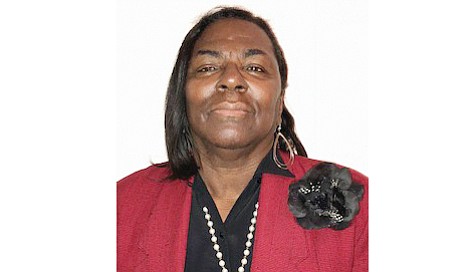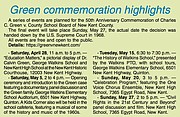Personality: Camilla Tramuel
Spotlight on chair of 50th anniversary commemoration of historic New Kent school case
4/13/2018, 8:46 a.m.
In the shadows of the assassination of Dr. Martin Luther King Jr., a little known Virginia school desegregation case was instrumental in changing the lives and education of schoolchildren across the commonwealth as well as the country.
Camilla Tramuel, chair of the 50th Anniversary Commemoration of Charles C. Green v. County School Board of New Kent County, is bringing the case out of the shadows and into the public spotlight, while establishing its rightful place in the annals of American history.
“We want everyone to know about the work and the role Charles Green’s case played in one of the most significant desegregation decisions by the U.S. Supreme Court,” Ms. Tramuel says.
The commemoration will include a series of educational and inspirational events, beginning Saturday, April 28, and continuing each week through the end of May.
The events will celebrate the legacy of Dr. Calvin C. Green, a pastor, science teacher and Richmond high school ROTC commander, who as president of the New Kent Branch NAACP, filed suit to ensure the promise of equal education under the landmark 1954 U.S. Supreme Court decision in Brown v. Board of Education would be fulfilled. The father of three sons, Dr. Green filed the lawsuit in 1965 on behalf of his youngest son, Anthony Green, who was in elementary school in New Kent County, where schools refused to desegregate despite the Brown decision.
At the time, Ms. Tramuel explains, there were only two schools in the county, with both spanning from elementary to high school — George Watkins for black students and New Kent for white students.
“George W. Watkins School was originally the New Kent Training School, founded in 1930 with Dr. George W. Watkins as its first and only principal,” she says.
While there were about 740 African-American students and 550 white students in the county at the time, when the white school got new books, “their old, torn, dirty books” were given to the black school, Ms. Tramuel says. “They had the ‘N-word’ scribbled across them, missing pages, not even a complete book,” she explains. “Our teachers did the best they could to piece books together so that we could have complete books to study from.” Desks and chair also were hand-me-downs, “missing legs and arms.”
Other examples of the county’s unequal treatment for the black school, Ms. Tramuel points out, were the amount of money per pupil pumped into the white school compared with the black school, as well as unequal pay for black teachers and the principal.
“In 1940, $70.12 was spent per white student versus $23.24 per black student,” she says. “The white principal was paid $2,095 per year and the black principal was paid $810 per year. The white teachers were paid $710. “If they had spent $50 per white student and $50 per black student…maybe we wouldn’t have complained,” she says.
To skirt the suit, the New Kent School Board instituted a “freedom of choice” system in which students could choose where they wanted to go to school. In the fall of 1965, 26 African-American students entered the all-white New Kent School, but no white parents sent their children to the all-black Watkins School.
“The School Board knew that no whites would apply to go to Watkins,” she says, “and only a few blacks would apply to enter New Kent. Why would white parents send their children to a school that they felt was substandard?”
In the end, Dr. Green, who was represented by legal stalwarts of the NAACP, including Oliver W. Hill Sr., Samuel W. Tucker and Henry L. Marsh III of Richmond, prevailed. The U.S. Supreme Court ruled on May 27, 1968, that state-sanctioned segregation must end quickly and that “freedom of choice” plans were unacceptable in bringing about desegregation and equity because they didn’t end the two-tiered public school system, Ms. Tramuel says.
The Green decision was overshadowed at the time by the death of Dr. King and its aftermath, Ms. Tramuel says, so media and public focus on the historic decision was lacking despite its importance. The Green decision also established six factors to determine whether a school system had reached an integrated status, Ms. Tramuel explains. Those factors include student assignments, faculty, staff, transportation, extracurricular activities and facilities.
As a result of the high court’s decision, “all school systems in the United States had to eliminate the two-school system and all state-imposed segregation, forcing school boards to convert to a single school system in which racial discrimination would be eliminated,” Ms. Tramuel explains.
In New Kent County, Watkins became New Kent Elementary, serving all students in the county, while New Kent became the high school, serving black and white students, Ms. Tramuel says.
“I didn’t go to the white schools during freedom of choice,” says Ms. Tramuel, the oldest of 10 children. “My mother waited until New Kent County established one school system and sent all of us then.” Once the schools were desegregated,” Ms. Tramuel says, “there was a gym and there were more sports for both boys and girls, such as basketball, baseball and football. New Kent began winning more games and even won a few championships the first five years of integration. New, long-lasting friendships developed. White people found out that black people were the same as they were.”
Since then, New Kent County’s population has grown. The school system is now 80.5 percent white and 10.3 percent African-American. There are two elementary schools, one middle school and one high school. Two lawyers involved in the case are planning to attend the commemoration events. Mr. Marsh, now 84, will attend the May 20 celebration service, while Michael Meltsner, 81, a former dean of the Northeastern University School of Law in Boston, will attend the May 27 event.
“New Kent is a small county, and people tend to bypass us when the travel from Richmond to Williamsburg and no one knows we are here. That’s the same situation with the Green v. New Kent decision,” Ms. Tramuel says. “The commemoration is extremely important to our country’s memory of desegregation,” she says. “If it wasn’t for Dr. Green, school integration may have taken 10 or more years longer.” Meet a keeper of the flame of history and this week’s Personality, Camilla Tramuel:
No. 1 volunteer position: Chair, 50th anniversary commemoration of Charles C. Green v. County School Board of New Kent County.
Occupation: Quality assurance specialist at Fort Eustis.
Date and place of birth: Born Oct. 20 in the Plum Point community of New Kent County.
Current residence: Yorktown.
Education: Bachelor’s degree in business management, Hampton University; master’s in acquisition and procurement management, American Graduate University.
Family: Daughter, Joi Angel Tramuel, 34.
When and why I became involved with 50th anniversary commemoration: A few of us had been discussing getting together to get this started in 2016. One day we decided to call a meeting to see who was interested. We had our first meeting in August 2017 for the purpose of planning a commemoration. Since we couldn’t decide on having just “one” event and what it would be, we decided to have an event every weekend except Mother’s Day weekend. The committee is composed of representatives from 10 different organizations throughout New Kent County.
Purpose of program: To remember the efforts of Dr. Calvin Coolidge Green, who made desegregation possible in New Kent County and throughout the United States. We also want everyone to know this little known black history fact about New Kent.
Why people should be interested: If it wasn’t for Dr. Green, school integration may have taken 10 years more or longer.
Impact on New Kent Public Schools: It was an adjustment for both black and white. How do you go from being all-black and all-white to being just classmates? Parents were scared. Hatred never goes away; it just settles somewhere else quietly. Private schools sprang up and white parents paid to send their children back to an all-white environment.
Impact on other public schools: All school systems in the United States had to eliminate the two-school system and all state-imposed segregation, forcing the school boards to convert to a one school system in which racial discrimination would be eliminated.
Why New Kent needed to be sued: It was something that needed to be done. Calvin Green was a man who only wanted the best of the best for his kids — the best education and the best of everything else. His son, Anthony, is a graduate of Virginia Military Institute.
Status of school integration in New Kent today: 100 percent.
Why milestone needs to be remembered: We should never forget times in history that not only affect you personally, but something that affects a whole country. How remarkable and unforgettable can that be? You can never erase what has already happened. Even if you take it out of the history books, it still happened. Even if it never made it to the history books, it still happened. Even if your parents never discussed it with you, it still happened.
How I start the day: God will always send me a beautiful day. Even if it rains, I’m still above ground.
A perfect day for me is: Hanging out with my family. I have nine brothers and sisters. Every Sunday is the traditional dinner at Mom’s. When we go places, on vacations, to dinner, etc., you can count on at least 10 to15, maybe 20, people.
Something I love to do that most people would never imagine: Can’t think of anything different that I do. Most people know me pretty well.
Kindergarten taught me: In New Kent, we didn’t have kindergarten. Lol. I think Head Start began when I was almost in high school.
A quote that I am inspired by: “To make history, create history!” I saw that on a sign and I added it to my signature block at work.
How I unwind: A good game of bid whist.
The top of my “to do” list is: You mean after Green is over? I am also president of the African American Heritage Society of New Kent. I must finish the newsletter. I am historian for St. Luke’s Baptist Church in Plum Point and working on our 105th church anniversary booklet. I have a lot to do and a short time to get it done! I am also co-author of a few New Kent County books that are under revision. I also have a few new ones that I need to finish.
The book that influenced me the most: I don’t have a favorite author or book. I am busy doing a lot of research and writing history, so I don’t read a lot of fiction.
My next goal: Retirement.








